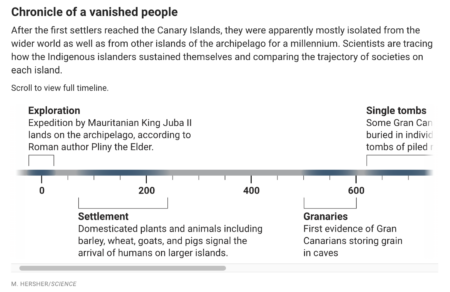- Frugivory by carnivores: Black-backed jackals are key dispersers of seeds of the scented !nara melon in the Namib Desert. Jackals pee on wild melon relatives and disperse their seeds, not necessarily in that order.
- Out of the Shadows: Reestablishing the Eastern Fertile Crescent as a Center of Agricultural Origins: Part 1. Go East, young archaeobotanists!
- Extinction risk predictions for the world’s flowering plants to support their conservation. Fancy maths says 45% of angiosperms are potentially threatened. Same for crop wild relatives in the Eastern Fertile Crescent? Black-backed jackals unavailable for comment.
- Global Wild Rice Germplasm Resources Conservation Alliance: WORLD WILD-RICE WIRING. Scientists get together to conserve global wild rice germplasm resources, understand the ecology of wild rice environments, identify and address threats, define effective ways to use wild species in rice improvement, and provide data for decision-making. Not a minute too soon, given the above.
- Morphometric analysis of wild potato leaves. Who needs genotyping anyway.
- Large-scale gene expression alterations introduced by structural variation drive morphotype diversification in Brassica oleracea. Brassica scientists need genotyping, apparently, that’s who.
- Exploring the nutritional potentials of wild Vigna legume species for neo-domestication prospects. Not much potential if they go extinct though. Quick, photograph their leaves!
Nibbles: Indian millets, Indian rice, Neolithic bread, Andean potatoes, UAE genebank, Niger onions, Lentil domestication, Italian rice, Sea cucumber
- The trouble with millets. Because there’s always room for a Star Trek allusion.
- Growing heritage rice varieties in Goa. With hardly any trouble, it seems.
- Really, really old bread. And more from Jeremy.
- Breeding company and CIP collaborating to save potato diversity in the Andes.
- Another genebank opens in the Gulf.
- The story of Niger’s Violet De Galmi onion. Or is it Niger’s?
- The latest crop to be called humble is the lentil.
- New varieties may help save risotto, but better water management will probably have to feature too, I suspect. Otherwise lentils could stand in I suppose.
- In the end, though, maybe we should all just cultivate sea cucumbers.
Brainfood: Archaeology edition
- Early human selection of crops’ wild progenitors explains the acquisitive physiology of modern cultivars. The high leaf nitrogen, photosynthesis, conductance and transpiration of crops was already there in their wild relatives, the first farmers just happened to domesticate greedy plants.
- The impact of farming on prehistoric culinary practices throughout Northern Europe. When the first farmers arrived in northern Europe armed with their greedy plants, they learned a lot about food from the local hunter-fisher-gatherers, and vice-versa, but without much interbreeding. Jeremy interviews one of the authors on his podcast.
- Early contact between late farming and pastoralist societies in southeastern Europe. There was extensive interbreeding between farmers and the local transitional foragers/herders before with the expansion of pastoralist groups into Europe from the Eurasian steppes around 3300 BC.
- Isotopes prove advanced, integral crop production, and stockbreeding strategies nourished Trypillia mega-populations. The earliest European mega-settlements, in Ukraine and Moldova, from around 4000 BCE, integrated greedy crops and generous domesticated livestock.
- Inference of Admixture Origins in Indigenous African Cattle. Following introduction from the Near East, domesticated cattle got admixed with a North African extinct aurochs before spreading throughout Africa.
- Flax for seed or fibre use? Flax capsules from ancient Egyptian sites (3rd millennium BC to second century AD) compared with modern flax genebank accessions. Fibre first.
- Revealing the secrets of a 2900-year-old clay brick, discovering a time capsule of ancient DNA. DNA from 34 plant groups were detected inside an old brick when it happened to break.
- Making wine in earthenware vessels: a comparative approach to Roman vinification. Comparison with modern counterparts shows that Roman clay jars for storing wine were integral to the process. No word on whether there was any ancient DNA in the clay.
- Breadfruit in the Pacific Islands, its domestication and origins of cultivars grown in East Polynesia and Micronesia. Spoiler alert: they came from Polynesian Outlier Islands.
Canaries in the genetic coal mine
Specialism in science being what it is, it’s understandably unusual to see papers which combine combine analysis of genetic diversity in humans over time with that of crops, or indeed livestock. It’s less understandable why it should also be unusual in science journalism, and examples should be celebrated. So hats off to Warren Cornwall for his very readable synthesis in Science of the history of human and crop genetic diversity in the Canaries over the past two thousand years. Well worth a read.
References
Nibbles: Fonio beer, ICRISAT seed kits, Dark Emu, China potatoes, 3D genebank, Bioculture, Microbiome genebank, Nutrition, Michigan kiwi
- You can make beer from fonio.
- ICRISAT providing Niger and Chad with sorghum and pearl millet seed kits. Fonio next?
- No, Echinochloa turneriana next. In Australia. I love the Dark Emu Hypothesis, and not least for its name.
- CIP is helping China improve its potato crop.
- Won’t be long before China’s genebank has 3D images of all its holdings. I’d love to see the potatoes.
- Want to see the earliest known site of domestication of teosinte?
- UK builds first crop biome cryobank.
- How the private sector can help with a more nutrition-sensitive agriculture. Should it want to.
- You can grow kiwi in Michigan. Should you want to.
